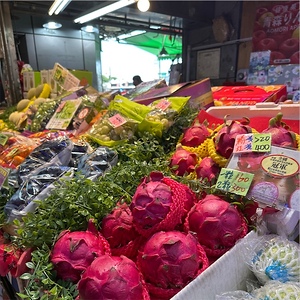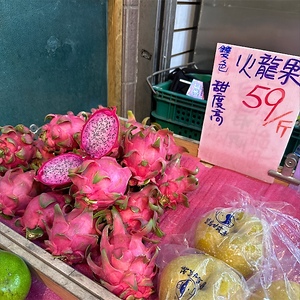


Taiwanese Bicolored Dragon Fruit
Estimated Inventory, lb : 0
Description/Taste
Taiwanese Bicolored dragon fruit varies in size depending on the season and growing conditions but generally averages 10 to 12 centimeters in length and 9 to 10 centimeters in diameter. The fruits are typically round, oval, and slightly elongated in shape, and the skin is thin, rubbery, matte, and lightly textured. Two defining characteristics of bicolored dragon fruits are their long, green-tipped scales and cork-like scars on the surface due to cracking during cultivation. The skin is primarily pink and can be easily peeled from the flesh once opened. Underneath the surface, the flesh just below the skin is pigmented with pink-red hues, and the flesh in the center is white. The flesh has a crisp, aqueous, and succulent consistency, becoming soft and creamy when chewed. Tiny, edible black seeds also pepper the flesh, adding a slightly crunchy mouthfeel. Taiwanese Bicolored dragon fruit releases a faint, sweet aroma, and the flesh ranges from 16 to 17 degrees Brix, sometimes reaching up to 22 degrees Brix. The variety’s sweet and slightly sour taste is refreshing, balanced, and light, complemented by faint floral nuances.
Seasons/Availability
Taiwanese Bicolored dragon fruits may be available year-round, but their highest production occurs from June to December.
Current Facts
Taiwanese Bicolored dragon fruit, botanically a part of the Selenicereus genus, formerly known as Hylocereus, is a category of two-toned fruits belonging to the Cactaceae family. The hybrid fruits were developed in Taiwan in the late 20th century, and several varieties were created by growers attempting to crossbreed red-fleshed dragon fruits with white-fleshed dragon fruits. Taiwan's two most prominent bicolored varieties are the Yuli Bicolored and Gaoshu Bicolored dragon fruits. Both varieties are named after their growing regions. In commercial markets, the varieties are generally labeled as Bicolored dragon fruit, Double Color dragon fruit, and Ice Cream dragon fruit, a marketing name highlighting the fruit’s sweet taste and creamy consistency. Bicolored dragon fruits are a specialty type not commonly found in markets. The fruits take twice as long to ripen compared to red or white-fleshed varieties, and growers must cover each fruit by hand in bags to protect the developing fruits against sun, weather, and pests during cultivation. It is also important to note that the coloring within the flesh changes in intensity depending on the weather and season. Summer fruits will have a lighter pink-red ring in the flesh, sometimes so faint they look almost entirely white. Fall and winter fruits will develop a more pigmented ring as temperatures between the night and day in cooler seasons allow for more color to develop in the fruits. Taiwanese Bicolored dragon fruits are cultivated as a delicacy and are showcased as fresh-eating fruit at high-end retailers and select specialty markets across Taiwan.
Nutritional Value
Taiwanese Bicolored dragon fruit is a source of fiber to regulate the digestive tract, vitamin C to strengthen the immune system, calcium to protect bones and teeth, and magnesium to control nerve functions. Dragon fruits also provide phosphorus to help produce genetic material such as DNA and RNA, iron to develop the protein hemoglobin for oxygen transport through the bloodstream, zinc to guard against viruses and bacteria, and other nutrients, including B vitamins and phytochemicals. The red-pink tone in the flesh indicates the presence of anthocyanins, natural pigments with antioxidant-like properties to guard the cells against the damage caused by free radicals and help to reduce inflammation.
Applications
Taiwanese Bicolored dragon fruit has a mild, sweet, and subtly sour taste suited for fresh and cooked preparations. The variety is primarily consumed fresh to showcase the flesh’s unique coloring. Bicolor dragon fruit is popularly sliced in half and scooped with a spoon or cut into wedges like an orange. These slicing methods allow each piece to showcase both the pink and white coloring. The flesh can be added to salads, layered into parfaits, mixed into fruit bowls, or served on appetizer platters. The fruit can also be blended into smoothies and shakes or used in other popular Taiwanese beverages, including bubble tea, lemonade, and juices. In addition to fresh preparations, Bicolored dragon fruit can be cooked into jellies, jams, syrups, and sweet fillings for cakes and other pastries. It can also be added to puddings, desserts, and sauces. In Taiwan, the red coloring in dragon fruit is sometimes extracted from the fruit and peels to add pigment to egg-based dishes such as omelets and tamagoyaki. The fruits can also be incorporated into fried rice, stir-fries, and meat dishes. Try grilling dragon fruit on skewers to develop a caramelized consistency. Bicolored dragon fruits pair well with other fruits, such as bananas, kiwis, pineapples, melons, and berries, honey, and brown sugar. Whole, unopened dragon fruits will keep for 1 to 2 weeks when stored in the refrigerator.
Ethnic/Cultural Info
Taiwanese Bicolored dragon fruits were celebrated in 2023 through a brand press conference to promote the specialty fruits grown in Hualien County. Hualien resides along the coastline in Eastern Taiwan, and the town of Yuli is especially known for its rich, fertile black soil sourced from the nearby mountains. This soil is said to provide essential nutrients for dragon fruit cultivation, and the temperature variation between day and night contributes to the fruit’s sweet flavoring and coloring. Bicolored varieties have remained relatively obscure in Taiwanese markets as several varieties range in coloring, quality, and flavor. Historically, bicolored varieties have not been commercially promoted, but since the release of an improved cultivar from Hualien cultivars in 2022, the Hualien County Government has partnered with the Yuli District Farmer’s Association to increase awareness of the specialty fruits. The 2023 press conference at the Taipei Regent Hotel featured innovative culinary dishes incorporating dragon fruit, including pink-hued bagels, tarts, and fruit cups. Bicolored dragon fruits are also being packaged in boxes that resemble the fruit’s unique scales and showcase a color variation, further promoting the fruit’s two-toned nature to attract consumer attention.
Geography/History
Taiwanese Bicolored dragon fruit was developed in Taiwan in the late 20th century. Dragon fruits, in general, were introduced to Taiwan sometime in the early 20th century, and commercially produced fruits from growers in Southern Taiwan began to appear in markets in the 1980s. Taiwanese breeders imported white and red-fleshed dragon fruit varieties from Vietnam and countries in Central and South America. Over time, Taiwanese growers began selectively breeding these varieties to create new cultivars better suited to Taiwan’s climate and growing conditions. Some growers chose to crossbreed white-fleshed and red-fleshed dragon fruits, eventually creating hybrids with a two-toned coloring. Select agricultural breeding facilities, especially in Fengshan, began working with growers to release hybrid fruits. Since their creation in the late 20th century, Taiwanese Bicolored dragon fruits are specialty varieties only sold as premium fruits. The fruits are not commercially grown on a large scale and are still somewhat rare in markets. In 2022, the Tainan District Agricultural Improvement Station of the Executive Yuan Committee of Agriculture released an improved bicolored variety developed from Hualien dragon fruit. Today, Taiwanese Bicolored dragon fruit is primarily cultivated in Nantou County in Central Taiwan, Hualien County in Eastern Taiwan, and Tainan and Kaohsiung Counties in Southern Taiwan. When in season, the fruits are transported to specialty markets across the island. The Taiwanese Bicolored dragon fruit featured in the photograph above was sourced from Binjiang Market in Taipei, Taiwan.









